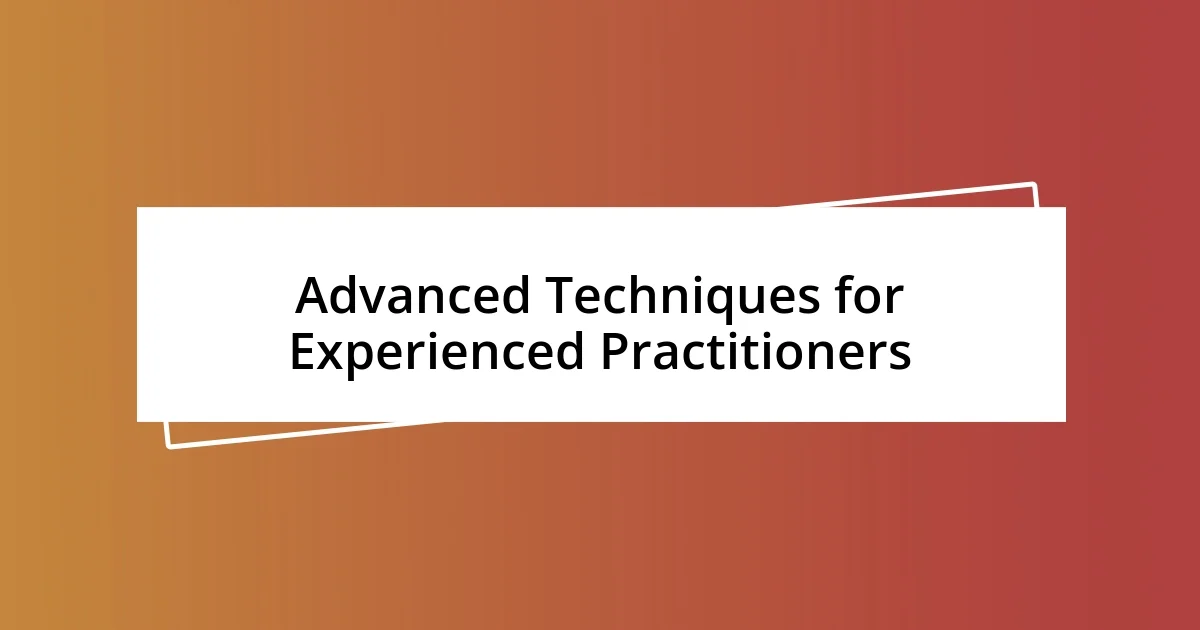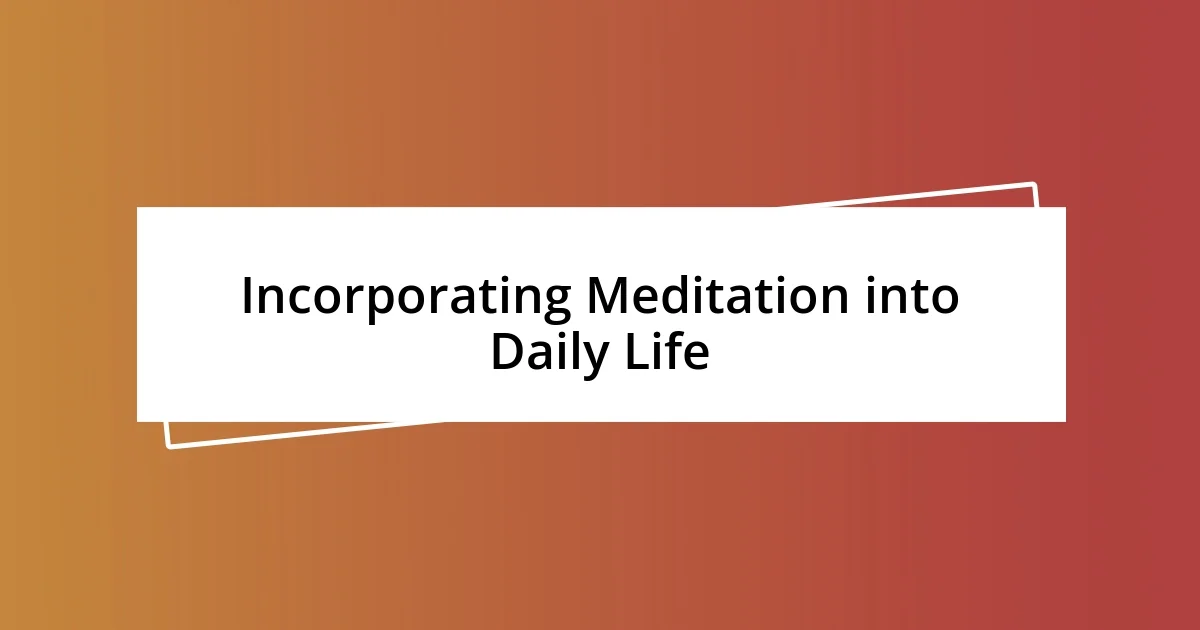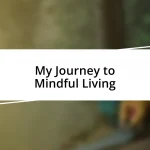Key takeaways:
- Meditation techniques vary widely and can lead to personal insights, with practices like loving-kindness meditation fostering self-compassion.
- Key benefits of meditation include stress reduction, enhanced clarity, and emotional resilience, positively impacting mental and physical well-being.
- Incorporating meditation into daily life, even in brief moments, can create a significant shift in mood and overall perspective, making it a valuable practice for both mornings and evenings.

Understanding Meditation Techniques
Meditation techniques can vary widely, reflecting the diverse needs and experiences of practitioners. I remember when I first ventured into mindfulness meditation; it felt foreign yet deeply comforting. Have you ever paused for a moment and found a blissful stillness amidst chaos? That’s what effective techniques can do—they offer pathways to tranquility.
Exploring different styles of meditation can lead to profound personal insights. One technique that resonated with me was loving-kindness meditation. Initially, I found it challenging to direct warmth towards myself, but over time, I discovered a deeper layer of compassion. It makes me wonder, have you ever considered how self-love plays a role in your journey?
Understanding the fundamentals of meditation techniques not only enriches your practice but also reveals your preferences. Some methods might leave you feeling energized, while others bring serene calmness. Have you ever noticed how a particular technique shifts your mood? That’s the beauty of meditation; it’s a unique experience for everyone.

Benefits of Powerful Meditation
Meditation offers a multitude of benefits that can enrich both your mental and physical well-being. One benefit I personally cherish is stress reduction. I vividly remember a time when I felt overwhelmed by work and life responsibilities; just a few minutes of focused meditation brought me back to a centered state. It’s fascinating how this practice can shift our perception of stress, turning a chaotic day into a manageable one.
Focusing on powerful meditation techniques can also enhance clarity and concentration. I often find that after a deep session, my thoughts flow more freely, making it easier to tackle complex tasks. Have you ever felt that rush of creative energy after meditating? It’s as if meditation unlocks a hidden reservoir of inspiration that we often forget is there.
Another profound benefit is the emotional resilience gained through consistent practice. I once struggled with feelings of anxiety, but powerful meditation helped me cultivate a sense of inner peace. Now, when challenges arise, I can navigate them with a calm mindset rather than being swept away by my emotions. It truly makes me wonder how many people could find similar strength through these techniques.
| Benefit | Your Experience |
|---|---|
| Stress Reduction | Helps with calming mind and body. |
| Enhanced Clarity | Increases focus and creative thinking. |
| Emotional Resilience | Builds strength to navigate life’s challenges. |

Basic Techniques for Beginners
When I first started meditating, I found myself overwhelmed by the notion that I had to reach a specific Zen-like state. Instead, I learned that simplicity is key for beginners. By focusing on the breath and grounding myself in the present moment, I could ease into a more relaxed state without self-imposed pressure.
Here are some essential techniques to kickstart your meditation journey:
- Breath Awareness: Concentrating on your inhalation and exhalation can anchor you in the present. I recall times when I simply counted my breaths to maintain focus.
- Body Scan: Mentally scanning your body from head to toe helps you notice tension. I often feel a release when I consciously acknowledge areas of tightness.
- Guided Meditation: Listening to recorded sessions can provide structure. I found several apps that offer beginner-friendly guides, which made it much easier to start.
- Mindful Walking: Incorporating meditation into movement can be grounding. I enjoy walking slowly and noticing the sensations in my feet and surroundings.
I can’t stress enough how valuable it is to embrace these techniques without judgment. It’s normal for your mind to wander, and when it happens, just gently redirect your focus. Meditation is a personal exploration, and it’s about finding what resonates with you.

Advanced Techniques for Experienced Practitioners
To deepen your meditation practice, consider integrating visualization techniques. I often find that visualizing a peaceful scene, like a serene beach or a quiet forest, enhances my ability to immerse myself fully in the moment. It’s like painting a mental canvas that calms my mind and refreshes my spirit. Have you ever tried this approach? The vivid scenes can transport you away from daily worries, offering a refreshing mental escape.
Another powerful method I’ve embraced is mantra meditation. This involves silently repeating a specific word or phrase, such as “peace” or “love.” I remember my first experience with mantras; it felt almost like a comforting lullaby soothing my mind. It helped me focus my thoughts and block out distractions. Do you have a favorite mantra? Choosing one that resonates can significantly boost your meditation sessions.
Finally, exploring meditative movement practices like Tai Chi or Yoga can elevate your experience. I recall my first class where the gentle flow of movement combined with breath felt like a dance of tranquility. It’s an inspiring way to connect body and mind, and I’ve found that these practices not only enhance my flexibility but also deepen my mindfulness. How about you? Are you ready to take your meditation out of stillness and into dynamic movement?

Mindfulness Meditation Techniques
Mindfulness meditation techniques offer a practical way to cultivate a deeper awareness of the present moment. Whenever I feel my thoughts racing, I engage in a practice called thought labeling, where I acknowledge my thoughts as “thinking” or “worrying” without judgment. This simple technique has transformed my experience, helping me detach from the content of my thoughts and observe them more like clouds passing in the sky. Have you tried it? It’s liberating to realize that you’re not your thoughts; you’re the observer.
Another technique I find profoundly beneficial is mindful eating. This became a favorite practice of mine when I started savoring each bite of my meals. By slowing down and paying attention to flavors, textures, and even the aroma of my food, I cultivate appreciation and awareness. I still remember one lunch where I truly focused on a simple apple—the crispness, the juiciness—it was like a revelation! Have you ever fully immersed yourself in a meal like that? It brings a newfound level of gratitude to the everyday act of eating.
Finally, integrating gratitude meditation into my routine has significantly shifted my mindset. Each session, I reflect on three things I’m grateful for, and I can feel my heart swell with positivity. It’s amazing how such a simple act can brighten my entire day. I often find myself smiling as I recall special moments or people in my life, creating a warm and uplifting energy around me. What are you grateful for today? Embracing gratitude can be a powerful anchor in mindfulness meditation.

Visualization Techniques for Meditation
Visualizing a space where I feel entirely at peace, like a sun-drenched meadow or a cozy cabin in the mountains, is a technique I frequently use in my meditative practice. As I close my eyes, I can almost feel the warmth of the sun and hear the gentle rustling of leaves—it’s like a mini-vacation for my mind. Have you ever allowed yourself to really settle into such vivid imagery? When I do, it’s not just relaxation; it’s a total reset that often inspires creativity and clarity long after I finish meditating.
Another favorite visualization technique involves imagining a radiant light swirling around me, enveloping me in calmness. This visualization isn’t just about aesthetics; it feels like a protective shield against negativity. I recall a particularly hectic day when I felt overwhelmed, so I took a few moments to breathe deeply and visualize that vibrant light. It was a transformative experience. I emerged from it feeling grounded and more capable of handling whatever came my way. Have you ever visualized a light surrounding you? It can really shift your perception of stress.
Finally, a technique I discovered through trial and error is visualizing my breath as a flowing wave. Each inhale is like the gentle rise of a tide, and every exhale is the retreat of water, taking away tension and worries. When I first tried this, I could feel the rhythm synchronize with my heart rate—an almost dance-like flow. It’s fascinating how this simple practice creates a physical sensation of relief, almost like a hug from the inside. Have you felt your breath moving through you like this? It’s a beautiful way to foster awareness and deepen your connection to your body during meditation.

Incorporating Meditation into Daily Life
Incorporating meditation into my daily routine has become a game-changer. I often start my day with just five minutes of mindful breathing while my coffee brews. This simple act sets a calm tone for the day ahead. Have you noticed how a few moments of stillness can create ripples throughout the day? I have found that even short sessions are enough to bring clarity and focus, like a gentle reset for my mind.
During busy moments, I sneak in meditation anywhere I can. Whether it’s taking a moment to breathe deeply while waiting for an appointment or implementing a brief body scan while standing in line, I remind myself that these small pauses can anchor my day. I remember one particular day when I felt frazzled at work; stepping into the restroom for a quick grounding exercise helped me tackle challenges with renewed energy. Have you ever realized how a few intentional breaths can remarkably shift your mood and perspective?
I’ve also embraced evening meditative rituals. Before bedtime, I dedicate time to reflecting on my day, often using a journaling technique alongside meditation. As I jot down my thoughts while focusing on my breath, I find it immensely cathartic. I often look back at those entries and see how my thoughts transform over time. Do you have a winding down practice that helps you transition into sleep? Incorporating meditation this way has become my essential tool for achieving restful nights, aiding both my mind and body in letting go.













